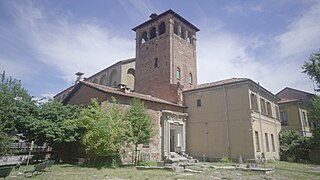Archaeological Museum, Milan
The Archaeological Museum of Milan (Civico Museo Archeologico di Milano in Italian) is located in the ex-convent of the Monastero Maggiore, alongside the ancient church of San Maurizio al Monastero Maggiore, with entrance on Corso Magenta.
The first part of the museum, sited in the original site of Corso Magenta, is dedicated to the history of Mediolanum (ancient Milan) founded in the 4th century BC and conquered by the ancient Romans in 222 BC. In the basement floor there is also a small section about Gandhara's arts. The inner cloister, where Roman remains (1st-3rd century AD) and two medieval towers are visible, connects the first part of the museum with the new building sited in via Nirone. In this part of the Archaeological Museum of Milan are sited, on four floors, the Early Middle Ages section, the Etruscan section, the Ancient Greek section and the temporary exhibition room.
In the Middle Ages polygonal tower sited in the inner cloister are exposed a Domenico Paladino sculpture donated by the artist to the museum that fits in the frescoed medieval structure.
Collections of the museum from prehistoric and Egyptian civilisations are housed at the Castello Sforzesco Museums.[1]
Statues and tombs from ancient Rome are displayed along the cloisters of the former monastery, and a path leads from the cloisters to a "polygonal tower (late third century) with early medieval frescoes (thirteenth century) and comes out in the new museum in Via Nirone where the early medieval section is on the first floor."[2]
Gallery
-
 Etruscan pear wood head. 7th century B.C.
Etruscan pear wood head. 7th century B.C. - Roman funerary stele, 1st century AD.
- The inner cloister.
- Archaeological remains.
- Ancient Greek vase.
- Statue of a deity enthroned, 5th century BC.
- Ancient Greek theatrical masks.
- Bodhisattva in meditation.
- Shiva and his mother, 10th century AD, from India.
-
 Italo-Corinthian helmet, 450-400 BC.
Italo-Corinthian helmet, 450-400 BC. -
 The Milan cage cup
The Milan cage cup -
 Roman tower within the Archaeological Museum.
Roman tower within the Archaeological Museum. -
 Section of Roman wall within the Archaeological Museum.
Section of Roman wall within the Archaeological Museum.
References
- AAVV, Milano, Touring Club Italiano, 2005
- https://web.archive.org/web/20120807072813/http://www.poliarcheo.it/
- http://www.comune.milano.it/museoarcheologico
 Media related to Museo archeologico (Milan) at Wikimedia Commons
Media related to Museo archeologico (Milan) at Wikimedia Commons
- v
- t
- e

| Cathedral | |
|---|---|
| Basilicas |
|
| Churches |
|
| Other |
- Alfa Romeo Museum
- Armani/Silos
- Bagatti Valsecchi Museum
- Castello Sforzesco
- Antique Furniture & Wooden Sculpture Museum
- Applied Arts Collection
- Archaeological Museum
- Egyptian Museum
- Museum of Musical Instruments
- Museo d'Arte Antica
- Pinacoteca
- Civic Aquarium
- Galleria d'Arte Moderna
- Gallerie di Piazza Scala
- Museo Civico di Storia Naturale di Milano
- Museo del Novecento
- Museo del Risorgimento
- Museo della Scienza e della Tecnologia "Leonardo da Vinci"
- Museo Diocesano
- Museo Poldi Pezzoli
- Museo Teatrale alla Scala
- Contemporary Art Pavilion
- Pinacoteca di Brera
- Triennale di Milano
- Casa Campanini
- Casa degli Omenoni
- Casa di Riposo per Musicisti
- Casa Manzoni
- Casa Panigarola
- Castello Cova
- Palazzina Appiani
- Palazzo dell'Arengario
- Palazzo della Banca Commerciale Italiana
- Palazzo Belgioioso
- Palazzo Borromeo
- Palazzo Carminati
- Palazzo Castiglioni
- Palazzo dei Giureconsulti
- Palazzo Mezzanotte
- Palazzo della Ragione
- Palazzo delle Scuole Palatine
- Palazzo del Senato (State Archives of Milan)
- Royal Palace of Milan
- Villa Belgiojoso Bonaparte
- La Scala
- Piccolo Teatro
- Teatro degli Arcimboldi
- Teatro Dal Verme
- Teatro Lirico
- EICMA
- Expo 2015
- Fiera Milano
- Milan Fashion Week
- Milan Furniture Fair
- Milan International (1906)
- Milan Triennial
- Oh bej! Oh bej!


























